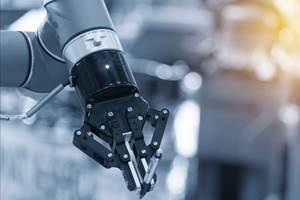Buying a Five-Axis: Selecting the Right Machine
Horizontal or vertical? Trunnion or swivel head? What’s the effective difference between different configurations of five-axis machining centers?
Not all five-axis machines are alike. Here’s where the application for which they will be used must be considered. You need to know what cutting speeds you’re going to run, for example. The type of spindle, the arrangement of rotary axes, rapid traverse rates, feed rates and available horsepower are other major considerations. Do you intend to machine primarily aluminum, stainless steel or titanium? How rigid does the machine need to be? What surface-finish quality do you require? What part accuracy are you trying to achieve? These are all questions you’ll need to answer in order to select the right machine for your application.
If you’re primarily machining aluminum, you may prefer a spindle capable of higher speed, such as 20,000 rpm, with higher rapid traverse rates, especially if you’re using smaller-diameter tools. Likewise, if you’re machining stainless or alloy steel for complex mold surfaces, you will likely be using small tools and high spindle speeds to achieve exceptionally smooth surface finishes.
Be aware that some machines are designed for cutting only aluminum. Others are suitable for steel and tough alloys, which require more rigidity, higher horsepower, lower spindle speeds, slower rotary speeds, higher torque and stronger box ways to make deep cuts with bigger tools. Machining different grades of steel, titanium alloys or even harder materials may require a heftier machine, however, this hefty machine would need to rotate the table excessively fast to achieve adequate surface speeds for cutting aluminum. The result might be disappointing.
When specifying out a five-axis machine, obtaining the expert advice of an experienced engineer is recommended.
Horizontal or Vertical
Horizontal five-axis machines are normally equipped with an automatic pallet changer (APC) ready to be installed on the shop floor. If you’re machining aerospace components that have deep pockets or waffling designed to reduce finished-part weight, the high volume of chips will naturally drop into the conveyor. In addition, horizontal five-axis machines tend to be heavier and more rigid, which helps when cutting steel and titanium.
In contrast, vertical five-axis machines tend to be more agile for processing smaller parts. VMCs tend to enable better operator access and can often take heavier cuts, but clearing chips can be inconvenient. High-pressure, through-the-spindle coolant delivery comes in handy to remedy chip accumulation.
Swiveling-Head or Trunnion Style
There are pros and cons to different types of machine designs. If you’re loading heavy parts, the non-tilting table on a swiveling-head machine is often preferred, because this type of table offers greater rigidity for holding big, heavy parts. The swiveling head enables the use of shorter, standard tooling, because all tool rotations occur above the part. Swiveling-head machines tend to be more versatile, lending themselves to using multiple fixtures, vises or tombstones. This somewhat simulates the appeal of an HMC.
A trunnion-style machine is often preferred in moldmaking, because both rotary axes are contained in the trunnion table itself and the spindle head is stationary. This configuration is similar to that of the three- or four-axis machines most moldmakers are already used to. The spindle head reaches out over the tilting table, providing better undercut capabilities and some access to the underside of the part. As the spindle head itself does not rotate, trunnion-style machines tend to be more effective in heavy chip removal and can use full X, Y and Z travels to accommodate large parts.
This is part three of a four-part series about buying five-axis machine tools.
- Part one: The Value Proposition of Five-Axis Machining.
- Part two: Buying a Five-Axis: The Costs and Benefits of a Complex Machine
- Part four: Buying a Five-Axis: Picking Options and Add-Ons
Find more insights about acquiring a new machining center by visiting the Techspex Knowledge Center, “Guide to Buying Machine Tools.”
Related Content
10 Things to Know About Creep-Feed Grinding
Because of the high material removal rate creep-feed grinding can deliver in challenging materials, grinding might not be just the last step in the process—it might be the process.
Read MoreThreading On A Lathe
The right choices in tooling and technique can optimize the thread turning process.
Read MoreWhen Organic Growth in Your Machine Shop Isn’t Enough
Princeton Tool wanted to expand its portfolio, increase its West Coast presence, and become a stronger overall supplier. To accomplish all three goals at once, acquiring another machine shop became its best option.
Read MoreChoosing a Five-Axis Machine Tool With Automation in Mind
While much focus is placed on the machinery that moves parts, the features most important for automating five-axis machining are arguably found in the machine tool itself.
Read MoreRead Next
The Cut Scene: The Finer Details of Large-Format Machining
Small details and features can have an outsized impact on large parts, such as Barbco’s collapsible utility drill head.
Read More3 Mistakes That Cause CNC Programs to Fail
Despite enhancements to manufacturing technology, there are still issues today that can cause programs to fail. These failures can cause lost time, scrapped parts, damaged machines and even injured operators.
Read More







.jpg;maxWidth=300;quality=90)
.png;maxWidth=300;quality=90)
















.jpg;maxWidth=970;quality=90)